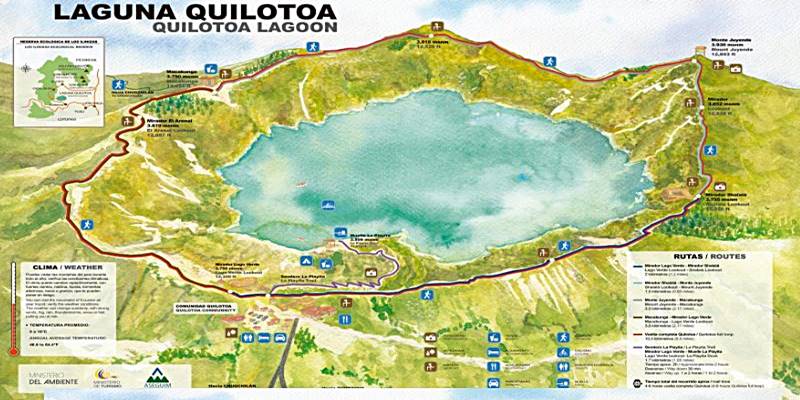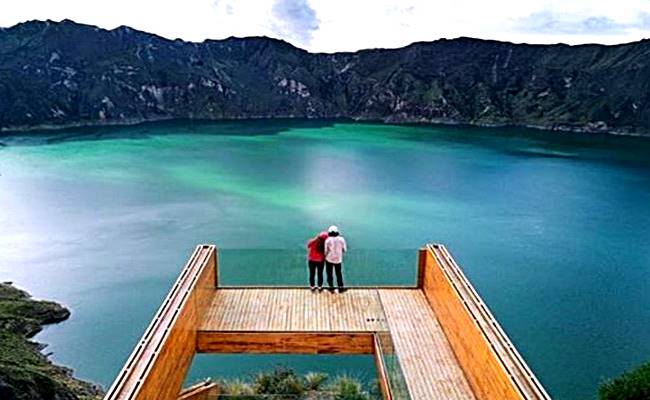The hike around Quilotoa Lake typically takes around 5-6 hours

Hiking around Quilotoa Lake is an unforgettable experience that offers breathtaking views of the turquoise waters and the surrounding Andean landscapes. The hike takes you around the entire rim of the crater, which is approximately 12 kilometers (7.5 miles) long. The trail is well-marked and relatively easy to follow, but it can be challenging due to the altitude and the steep climbs and descents.
Camping is a popular way to experience Quilotoa Lake, as it allows you to fully immerse yourself in the natural beauty of the area. There are several campsites located along the trail, which offer basic facilities such as toilets and water. Camping also allows you to witness the changing colors of the lake throughout the day, from the vibrant blues and greens of the morning to the fiery reds and oranges of sunset.

One of the highlights of camping at Quilotoa Lake is the opportunity to stargaze at night. Due to its remote location and high altitude, the lake offers some of the clearest and most stunning night skies in the world. The Milky Way is visible in all its glory, and shooting stars are a common sight. Camping at Quilotoa Lake is an unforgettable experience that will leave you feeling renewed and inspired by the beauty of nature.
Quilotoa Lake is a stunningly beautiful crater lake located in the Cotopaxi Province of Ecuador. Here are some interesting facts about this natural wonder:
- Quilotoa is a water-filled caldera, which was formed by the collapse of a volcano. The caldera is approximately 3 kilometers (2 miles) wide and is filled with turquoise water that changes color throughout the day.
- The lake is located at an altitude of 3,914 meters (12,841 feet) above sea level, making it one of the highest lakes in the world.
- The water in the lake is extremely acidic, with a pH level of approximately 0.7. This makes the lake inhospitable to most forms of aquatic life.
- The surrounding area is home to a number of indigenous communities, who have lived in the region for centuries. Visitors to the lake can interact with these communities and learn about their traditional way of life.
- Quilotoa is a popular destination for hiking and trekking, with a number of trails leading down to the lake and around the rim of the caldera.
- The lake is part of the Quilotoa Loop, a popular tourist route that takes visitors through some of Ecuador’s most scenic and culturally rich areas.
- Quilotoa has been designated as a protected area by the Ecuadorian government, in order to preserve its natural beauty and biodiversity.
- The lake’s unique color and stunning surroundings make it a popular spot for photography, and it has been featured in a number of films and documentaries.
- Quilotoa is considered to be a sacred site by the indigenous communities in the region, who believe that the lake has spiritual significance and healing properties.
- The lake’s name is derived from the Quichua word “killa,” which means “moon.” This reflects the belief of the indigenous people that the lake was formed by a falling star, which was transformed into the moon.
If you’re feeling adventurous, you can take on the more challenging Quilotoa Loop

The Quilotoa Loop is a popular trekking route in Ecuador that takes you through the breathtaking Andean landscapes, traditional indigenous villages, and stunning natural attractions. The highlight of the loop is the Quilotoa Lake, a beautiful turquoise-colored crater lake located at an altitude of 3,800 meters (12,500 feet) above sea level.
The trek usually takes 3-4 days to complete, covering a distance of approximately 50 kilometers (31 miles). The route starts and ends in the town of Latacunga, passing through several indigenous communities such as Tigua, Sigchos, and Chugchilán. Along the way, you will encounter stunning landscapes, including high-altitude moors, volcanic peaks, and deep canyons.
The Quilotoa Loop is a challenging trek that requires a good level of fitness and hiking experience. The highest point of the trek reaches 4,200 meters (13,800 feet) above sea level, so it’s important to take time to acclimatize to the altitude. Despite the challenges, the loop is a fantastic opportunity to immerse yourself in the local culture, taste traditional cuisine, and witness the way of life of the Andean people.
Overall, the Quilotoa Loop is a must-do for anyone seeking an unforgettable adventure in Ecuador. The stunning natural beauty, rich indigenous culture, and challenging trekking make it a unique and rewarding experience.

The weather on the Quilotoa Loop can vary depending on the time of year. Generally, the best time to visit is during the dry season, which runs from June to September. During this time, you can expect clear skies, sunny days, and chilly nights.
From October to May, the weather can be more unpredictable, with frequent rain showers and cloudy skies. This can make hiking more challenging, as trails can become muddy and slippery. However, the lush green landscapes and blooming wildflowers can make for a beautiful and unique experience.
It’s important to pack appropriately for the weather conditions, including warm layers for cold nights and rain gear for potential showers. It’s also recommended to check the weather forecast before embarking on the trek and to be prepared for sudden changes in weather patterns.
Looking to expand your knowledge about Ecuador? Check out our Everything Ecuador Page!


